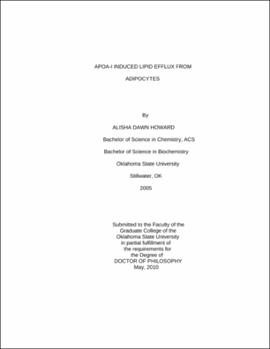ApoA-I Induced Lipid Efflux from Adipocytes
ApoA-I induced lipid efflux from adipocytes
| dc.contributor.advisor | Soulages, Jose L. | |
| dc.contributor.author | Howard, Alisha Dawn | |
| dc.date.accessioned | 2013-11-26T08:22:53Z | |
| dc.date.available | 2013-11-26T08:22:53Z | |
| dc.date.issued | 2010-05 | |
| dc.identifier.uri | https://hdl.handle.net/11244/6649 | |
| dc.description.abstract | Findings and Conclusions: | |
| dc.description.abstract | These studies have sought to characterize the apoA-I dependent lipid efflux of adipocytes. The rates of CL and PL efflux from adipocytes upon apoA-I incubation were determined and show that lipid efflux from adipocytes is induced by apoA-I at a similar rate as from macrophages. The CL to PL stoichiometric efflux ratio of adipocytes was also similar to the lipid efflux ratio seen in cAMP-treated macrophages, implicating by comparison the ABCA1-mediated pathway in adipocytes. | |
| dc.description.abstract | The 'efficiency' of apoA-I dependent lipid efflux, that is, lipid efflux normalized by ABCA1 cellular protein content, was found to be the same in both adipocytes and macrophages. To further test the role of ABCA1, the drugs GLYB, BFA and BLT4, which target the ABCA1 efflux pathway, were used to analyze apoA-I-dependent efflux from adipocytes. The results show patterns of inhibition expected for apoA-I induction of efflux via an ABCA1-mediated pathway. Collectively, the studies provide strong support for ABCA1 as the main transporter involved in lipid efflux from adipocytes to apoA-I. | |
| dc.description.abstract | Investigation of apoA-I internalization through use of pka-tagged apoA-I revealed that apoA-I is recycled in adipocytes. PKA-ApoA-I recycling was found to be a specific process that human apoA-I could compete with, but not apoLp-III or Thrx. The recycling was also saturatable and this lead to the proposition of receptor involvement in apoA-I cellular uptake and re-secretion. To investigate this, ABCA1 was tested as a potential recycling receptor but the ABCA1-inhibitor BFA failed to block apoA-I recycling. Similarly the drug BLT1, which blocks SRBI-mediated CL flux to HDL, also had no effect on apoA-I recycling. The next receptor to be tested was the ectopically expressed cell surface ATP synthase subunit β. Surprisingly, the phosphorylation of pka-apoA-I was blocked by use of a monoclonal antibody to ATPase β. | |
| dc.description.abstract | Finally, the ability of anti-ATPase β to block apoA-I internalization was used as a tool to directly analyze the relationship of apoA-I recycling to lipidation. CL and PL efflux assays carried out in the presence of anti-ATPase β showed that lipid efflux to apoA-I remained unaffected by antibody blocking of apoA-I recycling. This is the first direct study to show that apoA-I recycling is unrelated to apoA-I lipidation. | |
| dc.format | application/pdf | |
| dc.language | en_US | |
| dc.rights | Copyright is held by the author who has granted the Oklahoma State University Library the non-exclusive right to share this material in its institutional repository. Contact Digital Library Services at lib-dls@okstate.edu or 405-744-9161 for the permission policy on the use, reproduction or distribution of this material. | |
| dc.title | ApoA-I Induced Lipid Efflux from Adipocytes | |
| dc.title | ApoA-I induced lipid efflux from adipocytes | |
| dc.contributor.committeeMember | Mort, Andrew J. | |
| dc.contributor.committeeMember | Sunkar, Ramanjulu | |
| dc.contributor.committeeMember | Dillwith, Jack W. | |
| osu.filename | Howard_okstate_0664D_10800.pdf | |
| osu.accesstype | Open Access | |
| dc.type.genre | Dissertation | |
| dc.type.material | Text | |
| thesis.degree.discipline | Biochemistry and Molecular Biology | |
| thesis.degree.grantor | Oklahoma State University |
Files in this item
This item appears in the following Collection(s)
-
OSU Dissertations [11222]
